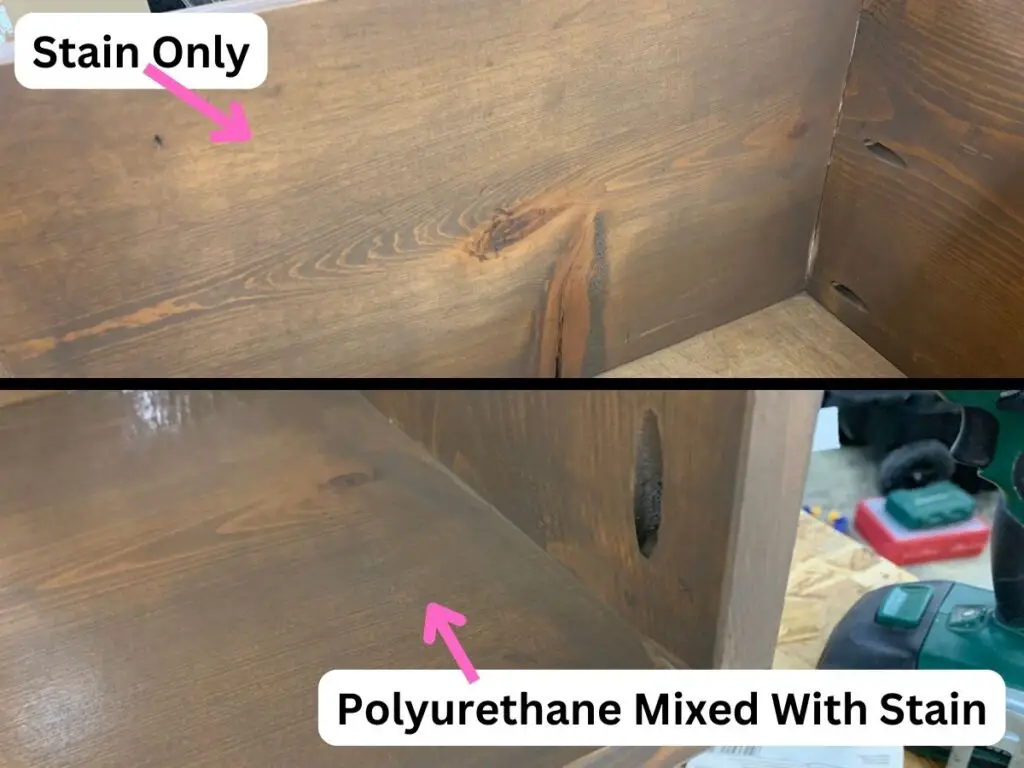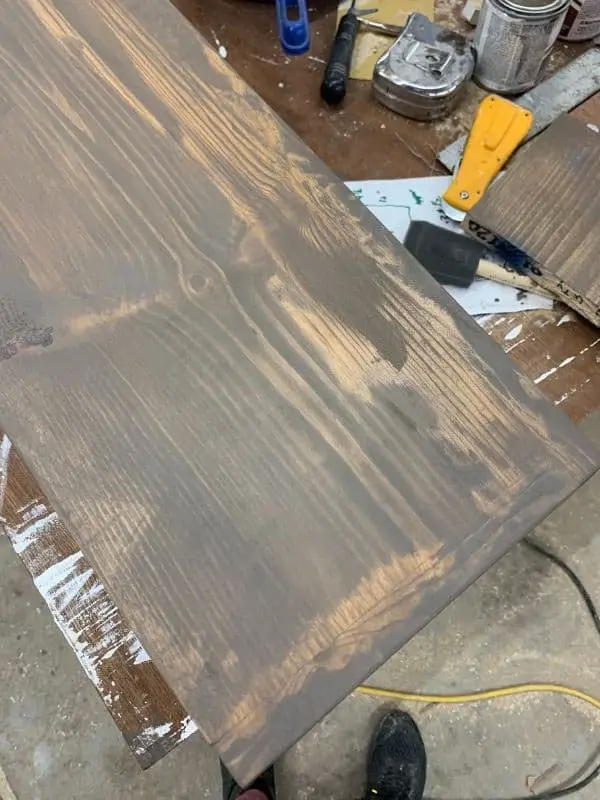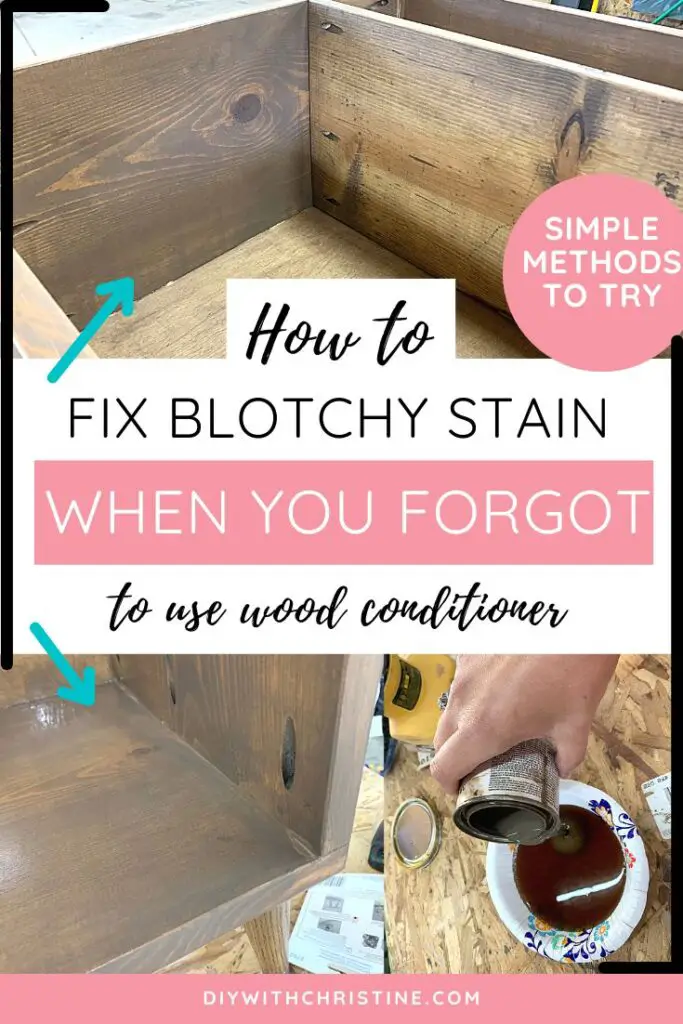*My posts may contain affiliate links, which means I may receive a small commission, at no cost to you, if you make a purchase through a link! Thank you for supporting my website!*
Last updated on February 28th, 2024 at 04:19 pm
Wondering how to fix blotchy wood stain when you forgot to use wood conditioner? Well, look no further because I have your answer!
Blotchy wood stain can be fixed by either sanding down and reapplying the stain or by mixing a small amount of stain into your topcoat before applying it over the blotchy stain.
Now that we’ve got the basics out of the way, let’s break into the details a little further so you can fix any unevenness in your wood stain (even if you forgot to use wood conditioner).
Let’s dive in!
Quick Navigation: Techniques To Fix Blotchy Wood Stain
- Method One: Mix The Stain Into The Topcoat Before Reapplying
- Method Two: Sand Down & Reapply The Stain
- Why Does Wood Stain Get Blotchy When Wood Conditioner Is Forgotten?
- Tips To Avoid Blotchy Wood Stain In The Future
- Final Thoughts
- Related Stain Articles
Method One: Mix The Stain Into The Topcoat Before Applying
The first method that I recommend trying to fix blotchy wood stain is to mix a little bit of stain into your topcoat.
There’s been a few instances where either I didn’t have wood conditioner on hand or forgot to use it and was a little disappointed in how my stain absorbed.
I quickly learned that having to sand the stain off and restart is not enjoyable and is a huge waste of time.
So I’ve found that depending on the darkness of the stain compared to the natural wood color, sometimes you can “cheat” a little bit.

If you mix a little bit of your stain into your topcoat before applying it, it can significantly help even out the color of the stain.
This is because any stain mixed into the topcoat gets “suspended” into the topcoat (instead of absorbing into the wood).
The suspended stain acts more like a glaze or a coat of paint rather than a stain. So this glaze can cover areas that aren’t absorbing as well.
The only problem with this method is it does significantly darken your stain color. Since more of the stain is sitting on top of the wood instead of absorbing into it, it creates a little more opaque finish than just applying a clear topcoat.

Of course, this is preferable when the stain is that blotchy. But if you are going for a light stain color, then this might not be the best technique.
I recommend trying this method first because it can be a huge time saver, and it’s possible you can avoid starting over.
If you try this method and still don’t like how the finish is turning out, then you can always try the next method.
Method Two: Sand Down & Reapply The Stain
The other method to fix blotchy wood stain is to sand down the wood, apply the forgotten wood conditioner, and reapply the stain.
Of course, sanding down the blotchy wood stain and restarting is the most time-consuming. But it will result in the best finish because you will be sanding, staining, and applying a topcoat properly.
I did that when I was staining my fireplace mantel because the wood filler I used stood out like a sore thumb under the stain.

If you used wood filler on your wood and your stain looks blotchy, then this is a totally different reason your stain looks uneven. You can check out my other article here on how to fix blotchy wood stain after using wood filler.

To fix this stain, I sanded down the entire piece and started over from scratch.
That helped me achieve a more even stain finish on my fireplace mantel.

If the first method doesn’t work, then you can always sand the stain and topcoat off and restart.
Why Does Wood Stain Get Blotchy When Wood Conditioner Is Forgotten?
Wood conditioner is mainly used for softwoods such as pine and is a super-thin layer finish that controls the level of stain penetration in wood.
This allows for consistent and even staining across the surface and usually prevents blotches from forming.
Without a wood conditioner, the wood pores sometimes have difficulty opening up evenly across the entire piece of wood. So the stain absorbs differently and creates a blotchy look.
Tips To Avoid Blotchy Wood Stain In The Future
There are several reasons that you can get those unsightly blotches on your wood, and following these tips can prevent this from happening most of the time:
- Clean the wood surface properly– dust and dirt on the wood surface can lead to particles getting trapped under the stain and can create blotches – so clean your wood well before applying conditioner or stain.
- Softwoods usually require wood conditioner – hardwoods like oak and walnut have more consistent density than softwoods like maple, birch, or pine. If you are working with softwoods, use the conditioner to ensure it evenly absorbs your stain.
- Sand your wood properly – uneven sanding can cause inconsistent results, so start with an orbital sander and coarser grit and then work down to the block sander with the finer grit and make sure your sanding pressure is even across the surface.
- Let the wood dry properly before staining – trapped molecules of water and moisture can cause severe blotches to appear, so it’s imperative that you only apply the stain once the wood is properly dry. This applies equally if you are adding a second or third stain layer.
- Wipe off excess stain – When applying stain, you need to wipe off any extra stain to prevent sticky or blotchy patches from forming on the surface. If you find a sticky patch, you can either wipe it with a rag (if the stain is still wet) or use some mineral spirits (for oil-based stains) or water (for water-based stains) to remove it, as this will not affect the stain underneath.
Final Thoughts On Fixing Blotchy Wood Stain
There you have it!
There are a couple of options to remedy unsightly and unwanted smudges, streaks, and smears in your woodworking.
Plus there are some simple precautions to lower the risk or prevent this from happening.
Fixing a blotchy wood stain when you forgot to use a wood conditioner is fairly straightforward, shouldn’t take long, and you should see good results if you follow the steps outlined above.
But before you do take on a staining project, check first whether you need a conditioner or not, as some woods can take the stain without it.
Catch you in my next post!


By Christine
Christine is a blogger and DIYer who tackles home renovation and decorating projects alongside her husband, Adam, for their personal residence and rental properties. Although she successfully tackles large renovation projects to avoid expensive contractor fees and bring her vision to life now, her path to success was not easy.
Go here to read her story, “From a Clueless First-Time Homebuyer To A Confident DIYer Creating Her Dream Home One Project At A Time“.
Popular Posts
DIY With Christine is a participant in the Amazon Services LLC Associates Program, an affiliate advertising program designed to provide a means for sites to earn advertising fees by advertising and linking to Amazon.com.






